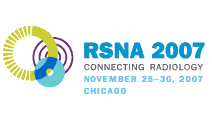
Abstract Archives of the RSNA, 2007
SSA01-06
DCEMRI of Breast Lesions: Is Kinetic Analysis Equally Effective for Both Mass and Non-mass-like Enhancement?
Scientific Papers
Presented on November 25, 2007
Presented as part of SSA01: Breast Imaging (MR Imaging)
 Trainee Research Prize - Resident
Trainee Research Prize - Resident
Sanaz A. Jansen, Presenter: Nothing to Disclose
Xiaobing Fan PhD, Abstract Co-Author: Nothing to Disclose
Gregory Stanislaus Karczmar PhD, Abstract Co-Author: Research Consultant, Perceptive Informatics, Inc
Employer Patent Holder, UCHI Patent # 092234-9059-00 titled "A Magnetic Resonance Imaging Method using Vanadyl-based Molecular Imaging Probes"
Employer Patent Holder, UCHI Patent titled "High spectral and spatial resolution magnetic resonacne imaging"
Hiroyuki Abe MD, Abstract Co-Author: Research grant, Totoku Electric Co, Ltd
Robert Albert Schmidt MD, Abstract Co-Author: Minor stockholder, Hologic/R2 Technology, Inc, Los Altos, CA
Research grant, Fuji Photo Film Co, Ltd, Stamford, CT
Research Grant, Konica Minolta
Consultant, Konica Minolta
Advisory Board, Konica Minolta
Spouse: Philips research grants
Spouse: Berlex, speaker's bureau
Gillian Maclaine Newstead MD, Abstract Co-Author: Research support, Fuji Photo Film Co, Ltd
Advisory Board, Konica Minolta Group
Advisory Board, Koninklijke Philips Electronics
Research support, Bayer AG
Speakers Bureau, Bayer AG
Spouse, stockholder, Hologic, Inc
To analyze contrast media uptake and washout kinetics in benign and malignant breast lesions using an empirical mathematical model (EMM) and to compare results obtained for these lesions with mass-like and non-mass-like enhancement characteristics.
34 benign and 78 malignant lesions were selected for review. Dynamic MR protocol: 1 pre and 5 post-contrast images using a T1-weighted SPGR with 68 second timing resolution. An experienced radiologist classified the type of enhancement according to the BI-RADS lexicon (mass, non-mass or focus) and generated a kinetic curve by tracing a region of interest around the most enhancing part of the lesion. The kinetic curve was analyzed quantitatively using the EMM:ΔS(t)=A(1-e-αt)e-βt, where A is the upper limit of signal intensity,α is the rate of signal increase, and β is the rate of signal decrease during washout. Several secondary parameters were derived including the initial slope (Slopeini), curvature at the peak (κpeak), area under the curve at 30 seconds (AUC30) and the signal enhancement ratio (SER).
Overall, there were 70 lesions with mass-like enhancement, 38 non-mass lesions and 4 focus. EMM parameters α, SER, Slopeini, and κpeak differed significantly between benign and malignant lesions (p0.5).
Kinetic parameters could distinguish benign and malignant mass lesions, but were not useful in discriminating non-mass-like benign from malignant lesions. This suggests that to maximize diagnostic utility, the first step before kinetic analysis should be to classify lesion morphology as mass or non-mass-like enhancement.
The diagnostic utility of kinetic analysis of breast lesions, i.e., in computer aided diagnosis schemes, is likely improved if performed after identifying the lesion as mass or non-mass enhancement.
Jansen, S,
Fan, X,
Karczmar, G,
Abe, H,
Schmidt, R,
Newstead, G,
DCEMRI of Breast Lesions: Is Kinetic Analysis Equally Effective for Both Mass and Non-mass-like Enhancement?. Radiological Society of North America 2007 Scientific Assembly and Annual Meeting, November 25 - November 30, 2007 ,Chicago IL.
http://archive.rsna.org/2007/5003279.html


 Trainee Research Prize - Resident
Trainee Research Prize - Resident